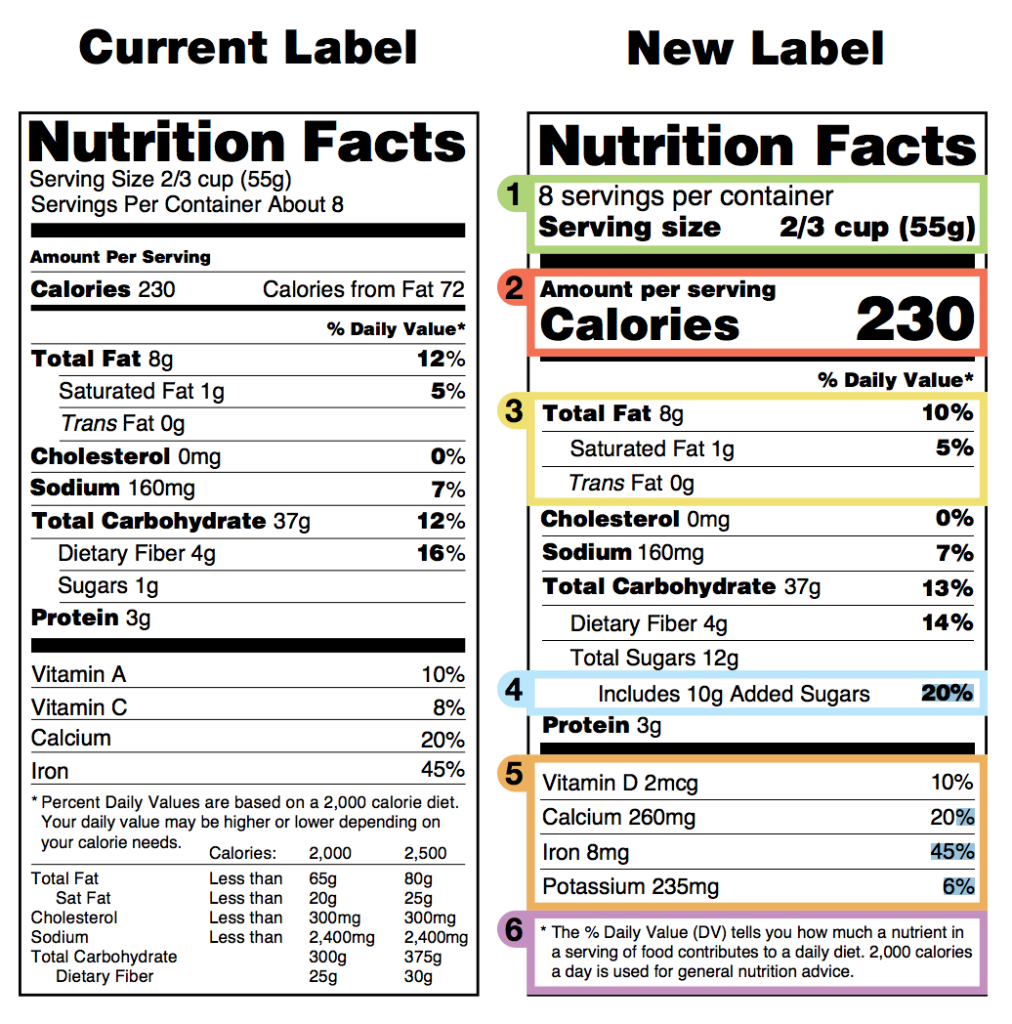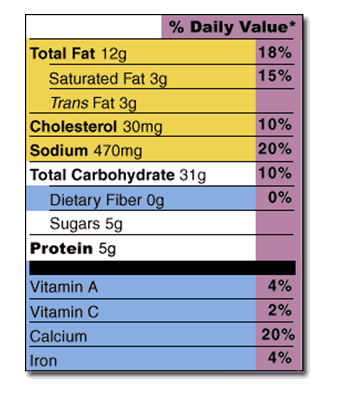44 nutrient requirements that are listed as percentages on food labels
The Basics of the Nutrition Facts Label Remember to aim high for percentage DV of these nutrients on other foods. Step 7: Consider the Additional Nutrients. You know about calories, but it also is important to know about the additional nutrients on the Nutrition Facts label. Protein: A percentage Daily Value for protein is not required on the label. How to Understand and Use the Nutrition Facts Label | FDA Dietary fiber, vitamin D, calcium, iron ad potassium are nutrients on the label that Americans generally do not get the recommended amount of. They are identified as nutrients to get more of....
Food Labeling Requirements - LabelCalc New August 2019 FDA Industry Guidance for Food Labeling: Folate, Niacin, Vitamins A, D & E. As of August 2019, the FDA released new guidance for the industry concerning food labeling for certain micronutrients listed on the nutrition facts label on food products.. Folate, Niacin, as well as Vitamins A, D, E are all receiving a do-over in their appearance on the nutrition facts label to be more ...
Nutrient requirements that are listed as percentages on food labels
Nutrition labelling | Food Standards Agency vitamins and minerals must be expressed per 100g/ml and as a percentage of the reference intake (RI) Calculation of nutrient values The legislation allows for different methods of calculating the... Changes to the Nutrition Facts Label | FDA The Nutrition Facts label on packaged foods was updated in 2016 to reflect updated scientific information, including information about the link between diet and chronic diseases, such as obesity... Food Labels | CDC - Centers for Disease Control and Prevention All the numbers on this label are for a 2/3-cup serving. This package has 8 servings. If you eat the whole thing, you are eating 8 times the amount of calories, carbs, fat, etc., shown on the label. Total Carbohydrate shows you types of carbs in the food, including sugar and fiber. Choose foods with more fiber, vitamins, and minerals.
Nutrient requirements that are listed as percentages on food labels. Nutrition information panels - Food Standards Nutrition information panels (NIP) on food labels provide information on the average quantity of energy in kilojoules or in kilojoules and kilocalories and these nutrients: protein fat saturated fat carbohydrate sugars sodium - a component of salt. A NIP will include information about other nutrients if a claim is made. Understanding Food Labels - Nutrition: Science and ... The FDA uses the following definitions for interpreting the %DV on food labels:4 5%DV or less means the food is low in a nutrient. 10% to 19%DV means the food is a "good source" of a nutrient. 20%DV or greater means the food is high in a nutrient. What are the Requirements for a Food Label? - Short Food ... When labeling mixes of fruits or vegetable juices on the label, you must list the fruits and vegetables in descending order of prominence by volume. The ingredient list is an exception to this rule. And if the label indicates that the juices are only used for flavor, then this rule does not apply. Helpful Resources for Food Labeling FDA Food Product Labeling & Packaging Requirements | ESHA ... Mandatory nutrients (total calories, total fat, saturated fat, trans fat, cholesterol, sodium, total carbohydrate, dietary fiber, total sugars, added sugars, protein, vitamin D, calcium, iron, potassium) Placement: In general, place the Nutrition Facts Label on the PDP or the Information Panel, near the ingredient statement. Ingredient Statement
How To Read Food and Beverage Labels | National Institute ... The percent Daily Value (% DV) tells how much a nutrient in a serving of the food or beverage contributes to a total daily 2,000-calorie diet. Although the average person needs 2,000 calories a day to maintain their weight, individuals may need more or fewer depending on their lifestyle. Ingredient lists and percentage labelling - Food Standards Percentage labelling. Most packaged foods have to carry labels which show the percentage of the key or characterising ingredients or components in the food. This allows you to compare similar products. The characterising ingredient for strawberry yoghurt would be strawberries and the label would say, for example, 9% strawberries. Nutrition Facts Label Size Requirements - LabelCalc Nutrition Facts Label Size Requirements and Font Standards . Whether you're just starting in the food manufacturing business or you have been in the game awhile, understanding FDA food labeling isn't easy or intuitive. Sifting through the lengthy documents outlining nutrition facts label size and format requirements can be time-consuming ... Nutrition Facts Labeling — FDA Reader The following vitamins and minerals are required on the nutritional label "Supplemental Facts" section. They must be measured in terms of percentage of daily value and weight. The minimum requirement is listed below (must be listed in this order): Vitamin D, Calcium Iron Potassium
Understanding Nutrition Facts on Food Labels - WebMD The percentages next to each nutrient -- such as fat, sodium, fiber, protein -- can help you determine whether a food is "high" or "low" in that nutrient. And 5% or less is considered to be "low,"... Learn How the Nutrition Facts Label Can Help You Improve ... Nutrients Required on Label Vitamin D and potassium values are required. Calcium and iron will continue to be required. Vitamins A and C will no longer be required but can be included on a voluntary basis. Slight Decrease in Sodium Allowance The daily limit for sodium decreased slightly from 2,400 mg per day to 2,300 mg per day. New FDA Food Labeling Guidelines Include Nutrition Facts ... Updated list of required if nutrients; Vitamin D, potassium, calcium, and iron will all be required. "Calories from fat" will be removed. Daily values for nutrients will be updated. Serving sizes will be updated to reflect the actual serving sizes the public are consuming. The new US FDA food labeling must be implemented by manufacturers ... A History of What Is Required on Food Labels and the ... The food ingredient panel, serving sizes and terms such as "low fat" and "light" are standardized. This is pretty much the nutrition label as we know it today. 1994: Nutrition Facts panel, basic per-serving nutritional information, is required on most foods under the NLEA of 1990. Food labels are to list the most important nutrients in an ...
Your Ultimate Guide to Food and Nutrition Labels - Aaptiv When it comes to something marketed as low sodium, Taub-Dix explains that it contains 140 or fewer milligrams of sodium. On the other hand, foods marketed as low calorie need to have 40 calories or fewer per serving. "Light" is similar in that way.
Food Labeling & Nutrition - U.S. Food and Drug Administration Food labeling is required for most prepared foods, such as breads, cereals, canned and frozen foods, snacks, desserts, drinks, etc. Nutrition labeling for raw produce (fruits and vegetables) and...
What is required on a food label? - USDA A meat and poultry label is required to contain 8 features. These are: the product name, inspection legend and est. number, handling statement, net weight statement, ingredients statement, address line, nutrition facts, and; safe handling instructions. These requirements are found in the Code of Federal Regulations (9CFR 317.2/381 Subpart N).
Presentation of Nutrition Information on Food Labels ... To assure that the nutrition information provided on a food label is conveyed in a manner that will allow the majority of consumers to use it successfully, a number of criteria need to be considered, including literacy of users, computational abilities, knowledge of English, and knowledge of the specialized vocabulary of nutrition labeling.


Post a Comment for "44 nutrient requirements that are listed as percentages on food labels"